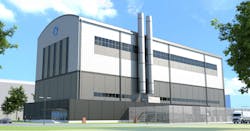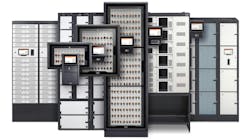Google’s Nuclear Move with Elementl Signals Broader Energy Shift for AI-Driven Data Centers
In a decisive step toward reshaping the energy backbone of its AI-driven infrastructure, Google has deepened its commitment to nuclear power through a strategic partnership with Elementl Power. The tech giant will support the early-stage development of three advanced nuclear energy sites from Elementl across the United States, each designed to deliver a minimum of 600 megawatts, for a combined capacity of 1.8 gigawatts.
Announced in early May, the agreement marks another inflection point in Google’s broader strategy to secure scalable, carbon-free baseload power capable of supporting the exponential energy demands of AI-centric data centers. The partnership also signals the sector's growing confidence in advanced nuclear technologies as a viable path to long-term sustainability and energy resilience in digital infrastructure.
Founded in 2022, Elementl Power aims to deploy over 10 gigawatts of advanced nuclear capacity by 2035. Google’s investment will fund key early-phase activities including site permitting, regulatory engagement, and commercial structuring. The backing of a hyperscale player like Google gives Elementl a formidable launch pad—and underscores the intensifying race among tech giants to lock in low-carbon power at scale.
As AI workloads push data center energy requirements to unprecedented levels, nuclear—once viewed as peripheral—is emerging as a cornerstone of next-generation power procurement strategies. With this move, Google isn’t just planning for the future; it's building it. The three Elementl facilities are expected to come online before the end of the decade, positioning Google to lead in deploying utility-scale nuclear energy for digital infrastructure.
Upon completion, Google will have the option to purchase power from these facilities. Amanda Peterson Corio, Global Head of Data Center Energy, Google, reflecting on the importance of these types of investments, said:
Google is committed to catalyzing projects that strengthen the power grids where we operate, and advanced nuclear technology provides reliable, baseload, 24/7 energy. Our collaboration with Elementl Power enhances our ability to move at the speed required to meet this moment of AI and American innovation.
Elementl Power Steps Into the Spotlight as a New Nuclear Catalyst
Founded just three years ago, Elementl Power is a relative newcomer to the nuclear energy landscape—but one with outsized ambition and strategic intent. Co-founder and President Ryan Mills describes the company as a purpose-built platform to address a critical industry gap: catalyzing private capital formation to accelerate advanced nuclear projects.
According to Elementl’s mission statement, the company aims to bridge the divide between nuclear technology providers, utilities, and major energy buyers—entities increasingly seeking long-term, carbon-free baseload power as AI infrastructure scales globally.
While Elementl has yet to disclose detailed leadership bios or a track record of past projects, its high-profile partnership with Google is a significant validation. Beyond the investment itself, the collaboration gives Elementl a marquee partner and a proving ground for its “technology-agnostic” strategy—allowing it to source the most promising reactor designs tailored to individual site and grid requirements.
That flexibility may prove critical as the advanced nuclear sector works to commercialize a new generation of reactor technologies over the next decade.
With industry targets converging on the 2030–2035 window for the first wave of commercial deployment, Elementl’s ten-year runway is ambitious—but not implausible. Traditional nuclear development timelines often stretch 15 to 20 years; Elementl’s modular, adaptable approach offers a pragmatic counterpoint. Success will depend on navigating evolving regulatory frameworks, aligning with state-level energy policies, and keeping pace with innovation from a growing cohort of advanced reactor vendors. For Elementl, nimbleness may be as important as engineering.
Google’s Nuclear Playbook Extends Beyond Elementl
The Elementl deal builds on Google’s expanding footprint in nuclear innovation. In October 2024, the company signed a Master Plant Development Agreement with Kairos Power, a California-based startup focused on developing small modular reactors (SMRs) using fluoride salt–cooled high-temperature reactor (FHR) technology. The agreement calls for the deployment of a fleet of Kairos reactors providing up to 500 megawatts of clean energy by 2035—an effort aimed squarely at meeting Google’s growing data center power demands with carbon-free baseload generation.
The first Kairos reactor is slated to go online by 2030, although full commercial deployment may extend several years beyond that. Still, the agreement marked a historic milestone: the first corporate commitment to procure energy from a network of SMRs, signaling a broader shift in how hyperscalers approach long-term energy procurement. Microsoft and Amazon have also engaged with next-gen nuclear developers through letters of intent, underscoring the rising stakes—and fierce competition—around securing future-proof power for data center growth.
Kairos Power, spun out of U.S. national laboratory and university research, has taken an iterative, vertically integrated approach to bring FHR technology to market. A key milestone came in December 2023, when the U.S. Nuclear Regulatory Commission approved a construction permit for Hermes, the company's low-power demonstration reactor in Oak Ridge, Tennessee.
This was the first construction permit granted for a non-light-water reactor in the United States in more than 50 years. Construction began in July 2024, and by May 2025, the first safety-related concrete was poured—marking real progress on what could be a pivotal commercial validation.
Backed by the U.S. Department of Energy’s Advanced Reactor Demonstration Program, Kairos believes it is on track to commercialize its reactor platform in the early 2030s. If successful, projects like Hermes could shift the economics and timelines of nuclear deployment across the data center industry—transforming how digital infrastructure is powered in an era of escalating AI workloads and decarbonization mandates.
U.S. Nuclear Momentum Accelerates Amid Policy Shifts and Hyperscale Demand
Google’s nuclear partnerships with Elementl Power and Kairos Power underscore a broader resurgence in U.S. nuclear energy—driven by hyperscale computing needs, evolving federal policy, and a maturing ecosystem of advanced reactor technologies.
In late May 2025, the U.S. Nuclear Regulatory Commission approved NuScale Power’s updated 77 MW small modular reactor (SMR) design, replacing its earlier 50 MW model. This milestone positions NuScale to potentially deploy its first SMR by decade’s end, contingent on securing a customer. Notably, NuScale is reportedly in discussions with five major data center operators, reflecting the sector’s growing interest in SMRs as scalable, carbon-free energy solutions.
Concurrently, President Trump’s administration has enacted a series of executive orders aimed at revitalizing the nuclear industry. These directives mandate expedited reactor licensing processes, authorize development on federal lands, and promote domestic uranium production. The policy shift has reportedly invigorated investor confidence, with companies like Oklo, Centrus Energy, and BWX Technologies experiencing significant stock gains.
The Department of Energy (DOE) is also advancing initiatives to bolster nuclear capacity. A comprehensive roadmap aims to add 35 GW of new capacity by 2035, with an annual addition of 15 GW by 2040. This plan includes repurposing existing power plant sites and transitioning coal plants to nuclear facilities.
In the private sector, tech giants are increasingly integrating nuclear energy into their infrastructure strategies. Amazon has partnered with Dominion Energy and X-energy to develop 5 GW of nuclear capacity, while Microsoft is exploring the revival of the Three Mile Island site for data center power. Oracle has announced plans for a gigawatt-scale data center powered by three SMRs, currently in the design phase.
These developments signal the rise of a transformative period for nuclear energy, aligning technological innovation with policy support and private investment to meet the escalating energy demands of the digital age.
Notably, in a recent episode of his independently produced podcast Data Center Richness (embedded below), Data Center Frontier founder Rich Miller explores the question, “How soon will nuclear-powered data centers become a reality?” in an in-depth conversation with industry veteran and DCF Contributing Editor Bill Kleyman, now CEO of Apolo.
At Data Center Frontier, we talk the industry talk and walk the industry walk. In that spirit, DCF Staff members may occasionally use AI tools to assist with content. Elements of this article were created with help from OpenAI's GPT4.
Keep pace with the fast-moving world of data centers and cloud computing by connecting with Data Center Frontier on LinkedIn, following us on X/Twitter and Facebook, as well as on BlueSky, and signing up for our weekly newsletters using the form below.
About the Author

David Chernicoff
Matt Vincent
A B2B technology journalist and editor with more than two decades of experience, Matt Vincent is Editor in Chief of Data Center Frontier.



